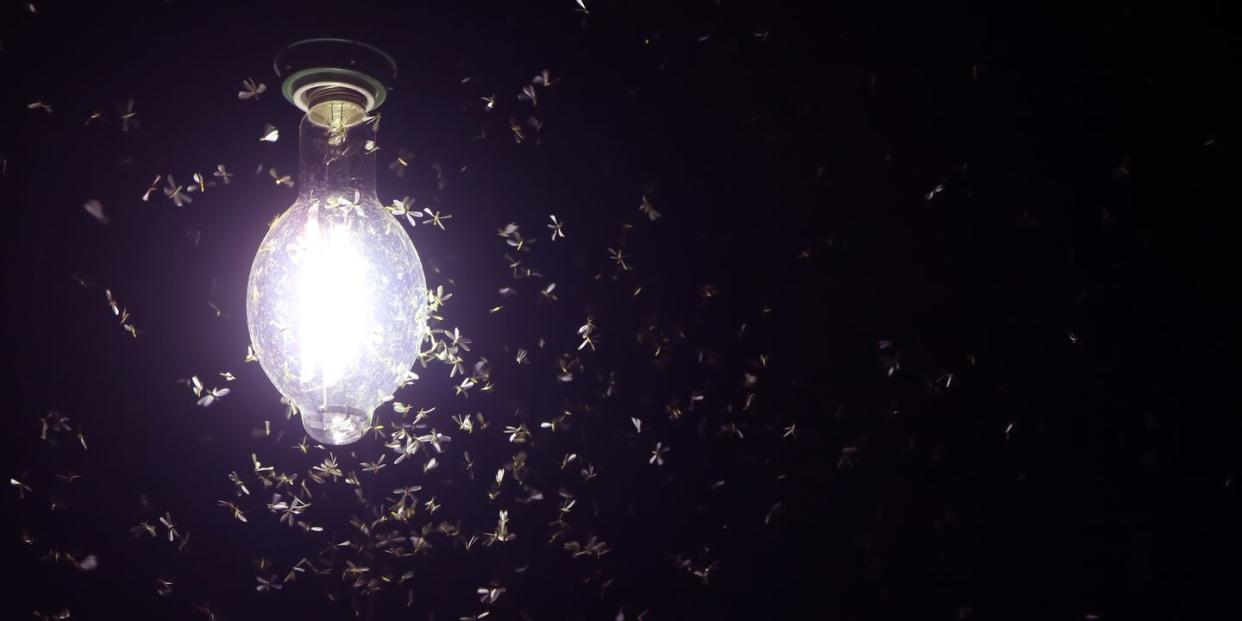This Simple Light Bulb Hack May Keep Bugs Away From Your Home

There’s nothing like dusk in the summertime. The sun finally starts to set, your clothes smell like the bonfire, the cicada sounds grow louder, and your porch light flickers on, illuminating the dozens of little bugs flying around the bulb.
Of course, most of these buzzing insects are harmless—but itchy bites are part of the territory if mosquitoes start floating around. And at that point, it’s understandable if you’d want to do what you can to minimize the amount of critters hanging around your home.
One hack that entomologists (a.k.a. insect experts) recommend? Switch out your light bulbs for LED lights—and pay close attention to the color.
Wait, why are some bugs attracted to light?
This is actually a question that’s still trying to be answered. “Nobody really knows for sure why some bugs are attracted to light,” says Howard Russell, M.S., an entomologist at Michigan State University.
Plus, “not all insects are attracted to light,” says Doug Webb, a board-certified entomologist and manager of technical services at Terminix International. The attraction to light is called phototaxis, he explains. Some bugs, like cockroaches, are actually repelled by light and thrive in the dark.
Phototactic insect species—meaning they’re attracted to certain wavelengths of light—include flies, moths, and mosquitoes, among others.
One theory behind their love of the light? “It’s an escape from an area or a predator—the light creates a clear path,” says Frank Meek, technical services manager at Rollins.
Another theory is that nighttime flying insects may use light as navigation system, similar to relying on the light from the moon to guide them, says Emory Matts, a board-certified entomologist for Western Exterminator.
And like any living thing looking for a safe place, it also may be that some insects are drawn in by the heat generated by certain lights, Meek says.
Do LED lights help keep bugs away?
Bugs are most drawn to the blue end of the color spectrum and ultraviolet light in particular. “Incandescent lights have a much broader spectrum of colors that are generated along with much more heat generated, both of which are attractive to many insects,” Webb explains.
Enter: LEDs, which “do not output much UV light,” Matt says, so it’s possible that switching your bulbs may make a difference. The wavelengths in typical LED household lights “are simply not the wavelengths that are most attractive to insects,” Webb adds.
In fact, in one 2016 study, researchers compared different types of light bulbs between July and September in open grassland around sunset (to ensure there was nothing else attracting the bugs). They collected insects in custom-made traps, and found that the worst option for outdoor lighting was traditional incandescent bulbs, which attracted the most bugs. LEDs on the other hand—both “cool‐white” and “warm‐white”—were the least attractive to insects.
Yellow-hued light bulbs are worth trying, too. “Yellow lights—and red lights—do not attract insects as much as regular white lights,” Russell says.
Other ways to keep bugs away from your home
Switching out your light bulb may lead to fewer bugs flying around—but you should also manage your expectations. A single light won’t be the only thing that deters pesky insects.
When bugs are lurking nearby—especially around doorways—there’s a good chance they’ll find their way inside, Meek points out. He recommends being mindful of the four things insects need to survive: food, water, a place to live, and proper temperature. So, if you want to get rid of them (and keep them away), you also need to keep those basic needs from them.
Consider making these additional moves:
Get rid of standing water. That includes making sure your flower pots have proper drainage and moving bird baths further away from your home.
Check your screens. Bright lights emitted from your home will also attract insects, Webb says, so make sure your window and door screens are in good shape. You’ll also want to keep your unscreened doors and windows closed.
Fix door seals. “A poor weather seal at the bottom of a door not only allows easy entry for insects, but may also allow light from indoors to illuminate the path for them,” Webb says.
Keep your outdoor space clean. That means keeping trash and food waste in covered containers, Matts says. It also doesn’t hurt to keep your outdoor garbage cans away from your doors and windows, if possible.
If you’ve tried making these changes and you’re still struggling with too many insects around your home, it’s probably time to call a pest management service for professional advice.
Go here to join Prevention Premium (our best value, all-access plan), subscribe to the magazine, or get digital-only access.
You Might Also Like

